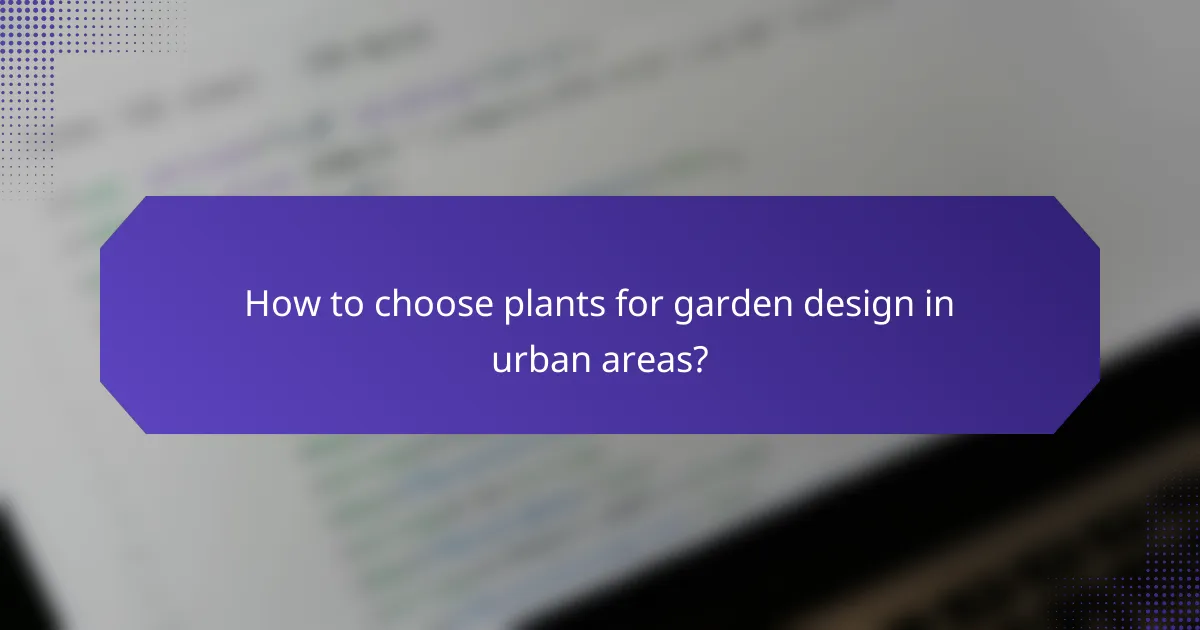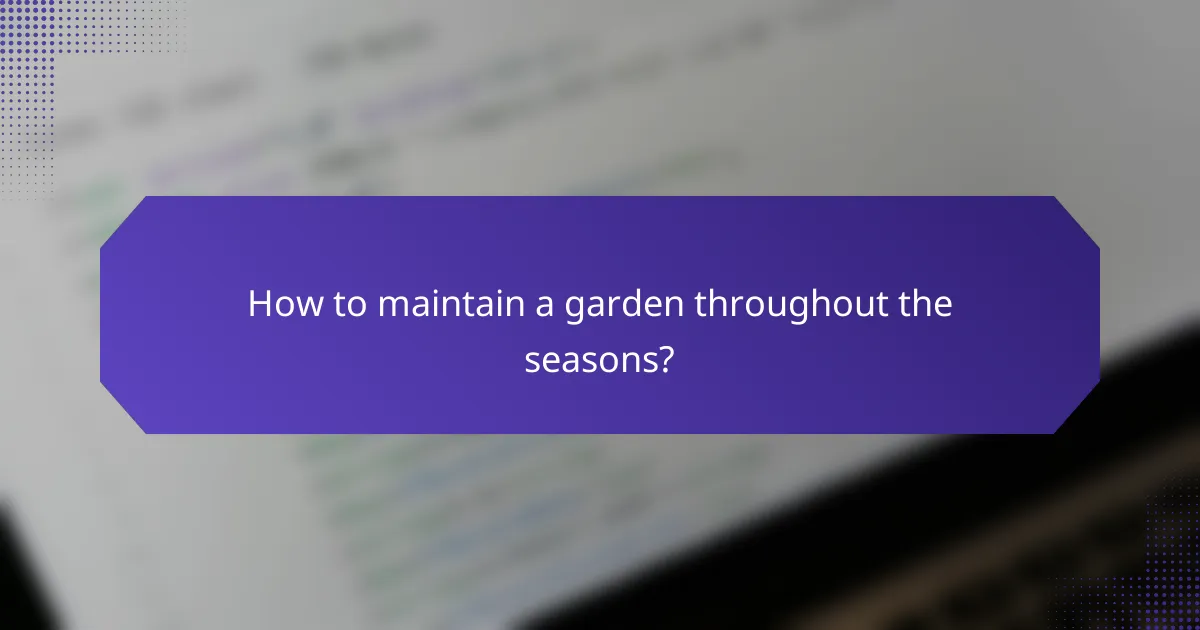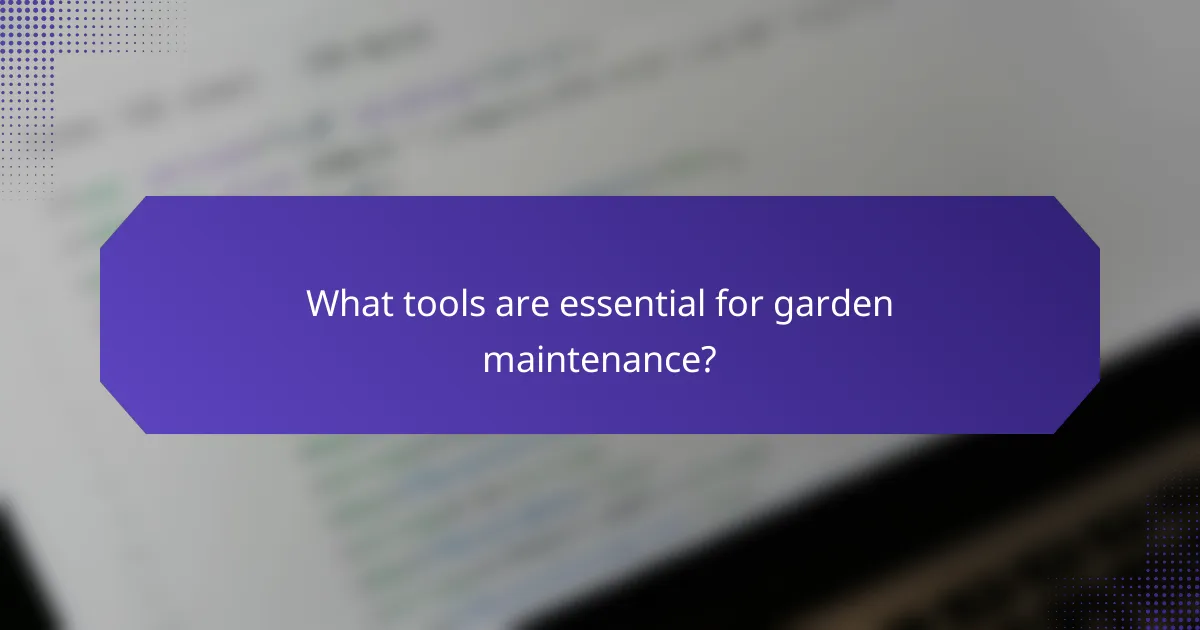Garden design is a thoughtful process that encompasses plant selection, layout planning, and ongoing maintenance. Choosing the right plants involves understanding their compatibility with urban environments, while effective layout planning enhances both beauty and functionality. Regular maintenance is essential to ensure that your garden remains vibrant and healthy throughout the seasons.

How to choose plants for garden design in urban areas?
Selecting plants for urban garden design involves considering factors such as space limitations, environmental conditions, and aesthetic goals. Prioritize plants that thrive in city settings, which often face challenges like pollution, limited sunlight, and soil quality.
Native plant selection
Native plants are well-suited for urban gardens as they are adapted to local conditions and require less maintenance. They typically resist pests and diseases better than non-native species, making them a sustainable choice.
Consider incorporating plants like coneflowers, black-eyed Susans, or native grasses, which can thrive in various urban environments. Research local flora to find species that will flourish in your specific area.
Climate-appropriate species
Choosing climate-appropriate species is crucial for ensuring your garden’s success. Select plants that can withstand your local weather patterns, whether hot summers, cold winters, or varying rainfall.
For example, in temperate regions, consider using perennials like daylilies or hostas, which can adapt to seasonal changes. In warmer climates, drought-tolerant plants such as succulents or lavender can be effective choices.
Color and texture considerations
Incorporating a variety of colors and textures can enhance the visual appeal of your urban garden. Aim for a balanced mix of flowering plants, foliage, and structural elements to create depth and interest.
For instance, combine vibrant flowers with lush green leaves and textured bark from shrubs or trees. This diversity not only beautifies the space but also attracts wildlife.
Pollinator-friendly options
Including pollinator-friendly plants is essential for supporting local ecosystems. Choose species that attract bees, butterflies, and other beneficial insects, which are vital for plant reproduction.
Examples of pollinator-friendly plants include milkweed, bee balm, and lavender. These plants not only contribute to biodiversity but also enhance the overall health of your garden.

What are effective layout planning strategies?
Effective layout planning strategies involve organizing your garden into distinct areas and utilizing space efficiently to enhance both aesthetics and functionality. Considerations include plant selection, accessibility, and the overall flow of the garden.
Garden zoning techniques
Garden zoning techniques involve dividing your garden into specific areas based on function or plant type. Common zones include vegetable patches, flower beds, and relaxation areas. This approach helps in managing plant care and creating a visually appealing layout.
When zoning, think about sunlight exposure, water needs, and maintenance requirements. For example, place sun-loving plants in the southern part of the garden and shade-tolerant varieties in the northern areas. This ensures optimal growth conditions for each plant type.
Vertical gardening solutions
Vertical gardening solutions maximize space by utilizing vertical structures to grow plants. This method is particularly useful in small gardens or urban settings where ground space is limited. Options include trellises, wall planters, and hanging pots.
Consider using climbing plants like beans or cucumbers for trellises, while herbs and succulents work well in wall planters. Vertical gardens not only save space but also add visual interest and can improve air circulation around plants.
Pathway design principles
Pathway design principles focus on creating functional and attractive routes through your garden. Pathways should be wide enough for easy access, typically around 60-90 cm, and made from materials that complement the garden’s style, such as gravel, stone, or pavers.
Ensure pathways are well-placed to connect different zones and provide clear navigation. Consider incorporating curves for a more natural look, and use edging to define the pathway. Good lighting along pathways enhances safety and aesthetics during evening hours.

How to maintain a garden throughout the seasons?
Maintaining a garden throughout the seasons involves regular care and attention to ensure plants thrive year-round. Key practices include seasonal pruning, adhering to appropriate watering schedules, and managing soil health effectively.
Seasonal pruning guidelines
Seasonal pruning helps promote healthy growth and flowering in plants. Generally, late winter or early spring is ideal for pruning most deciduous trees and shrubs, while summer is suitable for trimming perennials to encourage bushier growth.
Be cautious not to prune too late in the fall, as this can expose plants to winter damage. Always use clean, sharp tools to make clean cuts and minimize stress on the plants.
Watering schedules
Establishing a consistent watering schedule is crucial for maintaining a healthy garden. During the growing season, most plants require about 1 to 2 inches of water per week, either from rainfall or irrigation.
Water deeply and less frequently to encourage deep root growth, and adjust your schedule based on seasonal rainfall. Early morning is the best time to water, as it reduces evaporation and fungal diseases.
Soil health management
Maintaining soil health is essential for a thriving garden. Regularly test your soil to check pH and nutrient levels, aiming for a balanced mix that supports plant growth. Adding organic matter, such as compost or well-rotted manure, can improve soil structure and fertility.
Avoid compacting the soil by limiting foot traffic in garden beds and using mulch to retain moisture and suppress weeds. Rotate crops annually to prevent nutrient depletion and reduce pest buildup.

What are the benefits of professional garden design services?
Professional garden design services offer tailored solutions that enhance the aesthetics and functionality of outdoor spaces. These experts provide valuable insights into plant selection, layout planning, and ongoing maintenance, ensuring a garden that thrives and meets the homeowner’s vision.
Expert plant selection
Choosing the right plants is crucial for a successful garden. Professionals assess factors such as climate, soil type, and sunlight exposure to recommend plants that will flourish in your specific environment. This tailored approach helps avoid common pitfalls like selecting species that are not suited for local conditions.
Additionally, experts can introduce a variety of plants that provide year-round interest, including perennials, annuals, and shrubs. They may also suggest native plants that require less maintenance and are more resilient to local pests and diseases.
Customized layout planning
Layout planning is essential for maximizing the garden’s potential. A professional designer considers the space’s dimensions, existing features, and the homeowner’s preferences to create a cohesive and functional layout. This may involve zoning different areas for relaxation, entertainment, or gardening activities.
Effective layout planning also incorporates pathways, seating areas, and focal points, ensuring that the garden is both beautiful and practical. By visualizing the space, homeowners can make informed decisions about where to place plants, structures, and other elements.
Ongoing maintenance support
Maintenance is key to keeping a garden healthy and vibrant. Professional garden design services often include ongoing support, offering advice on seasonal care, pest management, and plant health. This ensures that the garden continues to thrive long after the initial design phase.
Homeowners can benefit from scheduled maintenance visits or consultations, which can help identify issues early and provide solutions. This proactive approach can save time and money by preventing larger problems from developing.

What tools are essential for garden maintenance?
Essential tools for garden maintenance include a variety of hand tools, power tools, and equipment that help keep your garden healthy and attractive. Investing in the right tools not only simplifies tasks but also enhances the overall efficiency of garden care.
Hand tools for pruning
Hand tools for pruning are vital for maintaining the health and shape of plants. Essential tools include pruning shears, loppers, and hand saws, each designed for specific tasks based on the size and type of branches being cut.
When selecting pruning shears, look for models with sharp blades and comfortable grips. For thicker branches, loppers with long handles provide the leverage needed to make clean cuts. Regularly sharpen and clean your tools to ensure optimal performance and prevent disease spread among plants.
Consider using bypass pruners for live branches and anvil pruners for dead wood. Always prune during the appropriate season for each plant type to promote healthy growth and flowering. Avoid cutting too much at once; a good rule of thumb is to remove no more than one-third of a plant’s growth in a single session.










